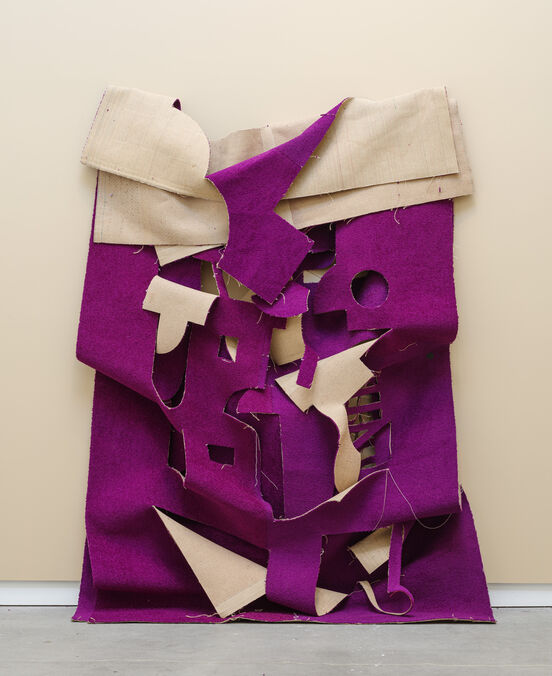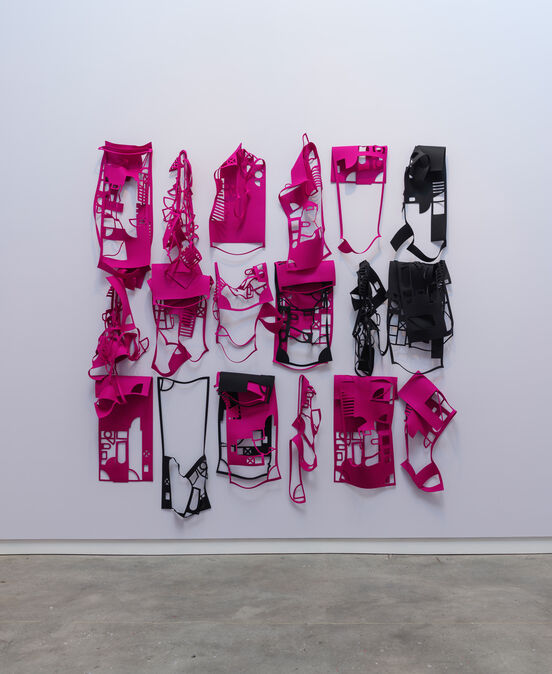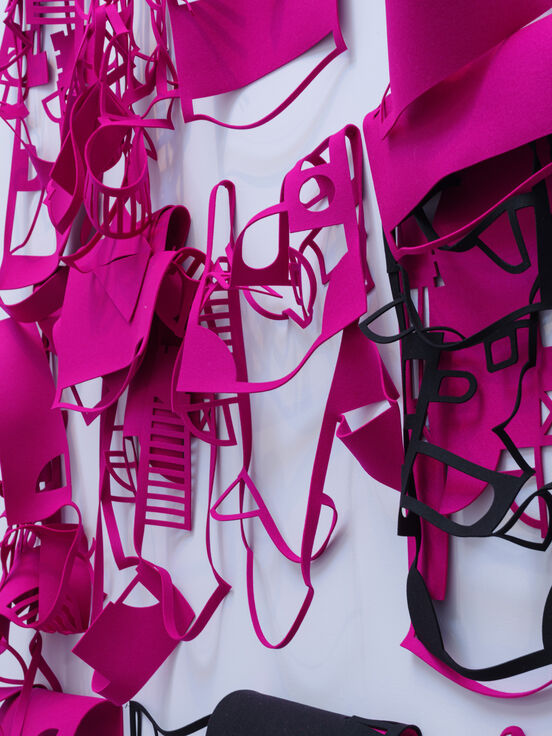Interview with Kirsty Lillico
Kirsty Lillico: I’m Kirsty Lillico, an artist from Te Whanganui-a-Tara Wellington. I make sculptures based on architectural floor plans; these often represent modernist high-rise social housing. I cut the shapes out of discarded carpet and hang them so they drape and slump. I am interested in the dictates of modernism, and in the way we live now, and whether modernist ideas still have relevance.
Objectspace: The exhibition was catalysed by the idea of hostile architecture. This provocation suggests that our experience of the built environment and place can be fraught – in a state of tension that prioritises some people’s needs over others’, and at odds with the natural world. What experiences do you have of hostile architecture in your daily life?
KL: My first experience with hostile architecture probably occurred while growing up in the Hutt Valley. The Upper Hutt city council chambers, town hall, library and Central Institute of Technology (in Heretaunga) are all designed in the Brutalist style. The exposed concrete formwork and imposing scale of these buildings represented power, authority and control. I didn’t know the term Brutalism (from béton brut, the French term for raw concrete) then, but if I had I’m sure I would have thought that the word referred to something brutal and inhumane. They didn’t look like structures that encouraged lingering or play; the rough concrete ribs of the CIT looked alarmingly skingrazing. They were both permanent-looking, like a cliff-face or a mountain, like something that has always existed and futuristic, in a way that I didn’t see in the newer buildings around me. So there was a kind of temporal dissonance. How come these buildings looked like the kind of structures I saw in sci-fi films? Yet they were built before I was born.
OS: What drew you to investigating the Gordon Wilson Flats as a site?
KL: I became interested in this building when I saw a thread on Facebook by Victoria University students perplexed by the vacancy of this enormous building, owned by the university, that they passed every day on their way to study. This was at the beginning of the academic year as they were searching for accommodation in a city beset by a housing shortage. So I started following the university’s attempt to get the area re-zoned and the building removed from the City District Plan’s heritage list.
This building links to my interest in the history of highrise social housing and in a previous Labour government’s experimentation with high-density inner-city housing as a way to address sprawl and improve living conditions during a time which parallels our current housing crisis. Some people say it was a good thing that New Zealand didn’t invest heavily in this model for high-density housing, as in America and Europe similar schemes became linked with social issues. In many instances social problems were exacerbated by housing at-risk populations in buildings that were poorly maintained and with insecure communal spaces (particularly staircases and lifts). I think you could look at one of my sculptures and say that the theme of ‘failure’ is definitely present.
Modernist architecture has been employed as a dystopian backdrop in countless films, feeding the popular opinion that these buildings are cold, authoritarian and depressing. This rhetoric of fear has been seized on by politicians, developers and other forces keen to erase the traces of our recent past.
I often think about International Style modernism and how its socialist ideals rapidly became co-opted as a style, one that we now associate with late capitalism and the visual language of corporations (the office tower, etc.). Gordon Wilson Flats represent a direct link to European International Style modernism. A number of the European émigré architects who came to New Zealand in the 1930s and 1940s, including Friedrich Neumann (Fred Newman) and Ernst Plischke, found employment with the Department of Housing Construction, and brought with them the architecture and urban visions of Le Corbusier and the Bauhaus. They believed in the power of architecture to transform society.
OS: Tell us more about the work you’ve made in response.
KL: I’m using the two void spaces at CoCA. One space holds a sculpture made out of purple-violet carpet, entitled Big Love. The sculpture represents an architectural floor plan of a two-bedroom flat from the Gordon Wilson Flats, The Terrace, Wellington.
The other space has a group of felt sculptures that are machine-cut, all representing the various floor plans of GWF (studio, one bedroom, two bedroom). The cuts will vary so that the folds of each sculpture fall in a slightly different way.
This work expands my use of colour. The initial inspiration behind my choices were the films Suspiria (1977), directed by Dario Argento, and The Shining (1980) and A Clockwork Orange (1971), directed by Stanley Kubrick. The interiors of these films employ a bright ‘pop’ colour palette which is a contrast to the psychological horror that plays out without them. I am interested in the way that modern architecture has been stigmatised in part through its inclusion as a backdrop in dystopian works of fiction.
The purple carpet I am using was salvaged from a chapel designed by Austrian/New Zealand architect Fritz Eisenhofer, who was known in the 1970s for designing large houses popular for hosting society parties. These were characterised by conversation pits and bathrooms with no doors.
This text is republished from Toro Whakaara: Responses to our built environment, a publication produced by Objectspace to accompany an exhibition of the same name. The publication is edited by Tessa Forde, and copy-edited by Anna Hodge.

Kirsty Lillico, Big Love, 2021 exhibiting at CoCA Toi Moroki as part of Toro Whakaara: Responses to our built environment presented by Architectus. Photograph by John Collie.

Kirsty Lillico, Flats, 2021, exhibiting at CoCA Toi Moroki as part of Toro Whakaara: Responses to our built environment presented by Architectus. Photograph by John Collie.

Kirsty Lillico, Flats (detail), 2021. Photograph by John Collie.